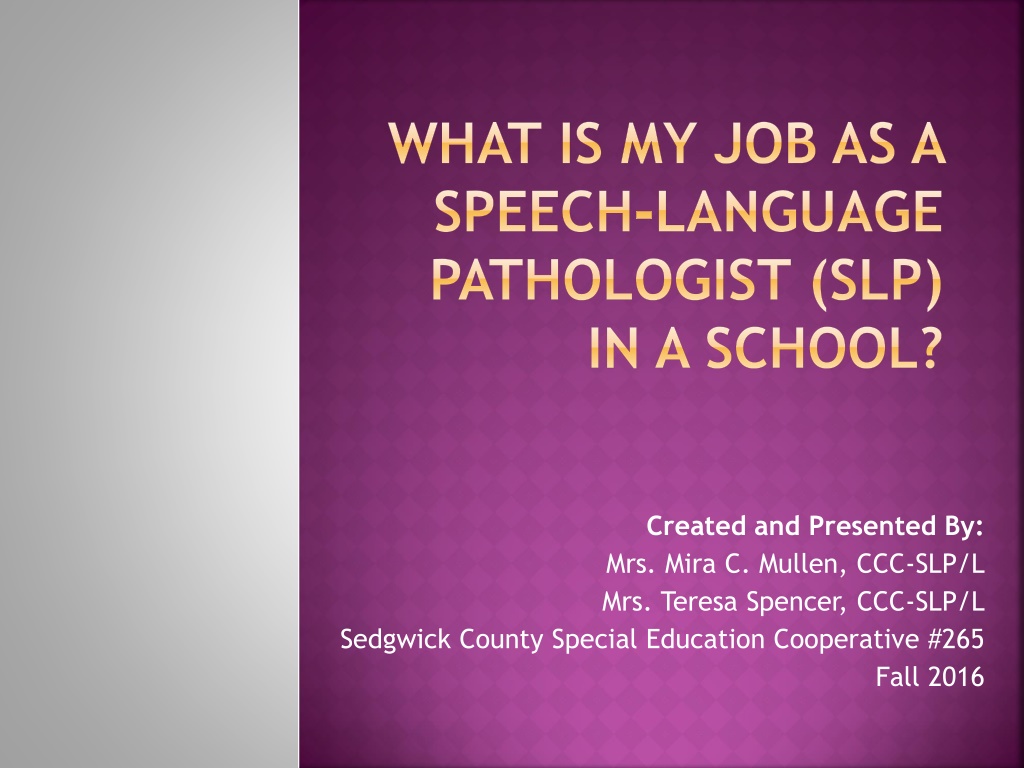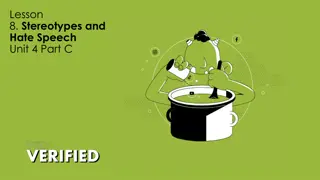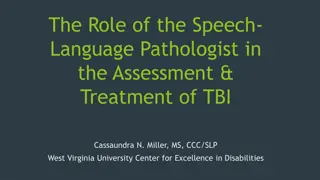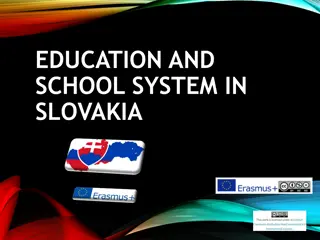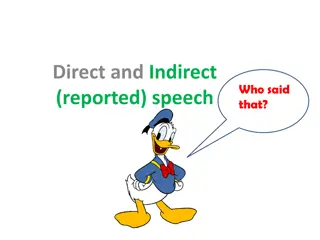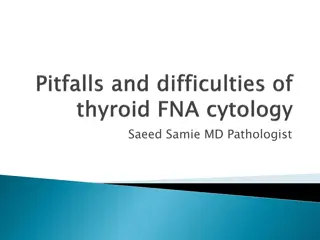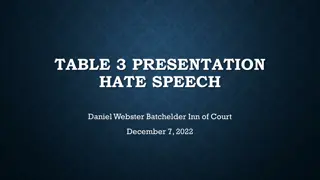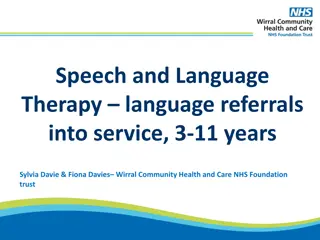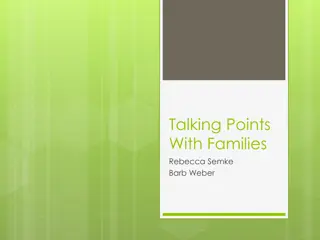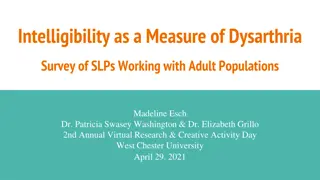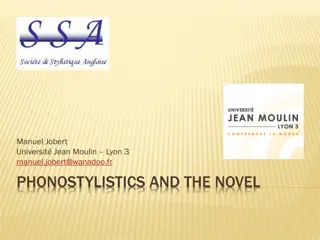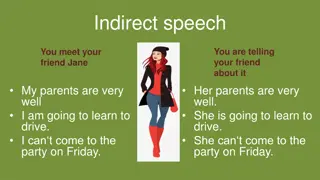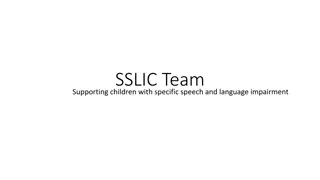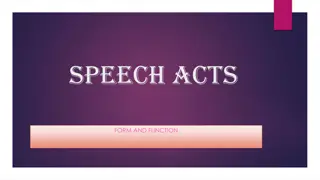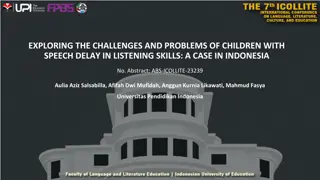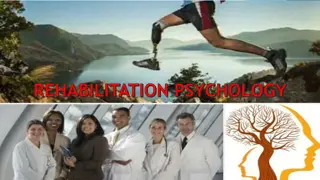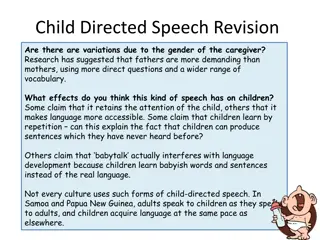The Role of a Speech-Language Pathologist in Schools
As a Speech-Language Pathologist (SLP) in a school setting, your job involves assessing and treating children with communication disorders that impact their academic success and social interaction. Requirements in Kansas include a Master's degree, supervised clinical practicum, passing exams, and continuing education. Communication is crucial in schools for learning and building relationships. SLPs, also known as speech therapists or speech teachers, work to improve students' communication skills. Students qualify for speech services under the Individuals with Disabilities Act if they have communication disorders affecting their educational performance.
Download Presentation

Please find below an Image/Link to download the presentation.
The content on the website is provided AS IS for your information and personal use only. It may not be sold, licensed, or shared on other websites without obtaining consent from the author. Download presentation by click this link. If you encounter any issues during the download, it is possible that the publisher has removed the file from their server.
E N D
Presentation Transcript
WHAT IS MY JOB AS A SPEECH-LANGUAGE PATHOLOGIST (SLP) IN A SCHOOL? Created and Presented By: Mrs. Mira C. Mullen, CCC-SLP/L Mrs. Teresa Spencer, CCC-SLP/L Sedgwick County Special Education Cooperative #265 Fall 2016
WHAT ARE THE REQUIREMENTS OF AN SLP IN KS? Initial License for Speech Language Pathology in Kansas Master's degree or equivalent from an educational institution with standards consistent with those of the state universities of Kansas or accredited by ASHA 400 hours supervised clinical practicum, at least 325 hours at graduate level, in the area in which licensure is sought (audiology or speech-language pathology) Completion of supervised 9-month postgraduate professional experience (CFY- Clinical Fellowship Year) Passage of a National Teachers Exam Specialty Area test administered by ETS (NTE) Passage of the National ASHA Praxis examination in the area which licensure is sought. Continuing Education Kansas - Applicants must complete 20 hours of documented and approved continuing education per each two-year renewal period. National (optional in the school setting) Being ASHA certified" means holding the Certificate of Clinical Competence (CCC), a nationally recognized professional credential that represents a level of excellence in the field Speech-Language Pathology(CCC-SLP). ASHA Certification Maintenance Standards require that all certificate holders (CCC-A and CCC-SLP) must accumulate 30 Certification Maintenance Hours (CMHs) of professional development during each 3-year certification maintenance interval in order to maintain their ASHA Certificates of Clinical Competence (CCC).
HOW IMPORTANT IS COMMUNICATION IN THE SCHOOL SETTING? Good communication skills lead to success in Reading Listening Writing Speaking LEARNING! 21st Century Skills Bad communication skills lead to problems with Understanding & participating in classroom instruction Developing & maintaining relationships
A.K.A. SPEECH THERAPISTS OR SPEECH TEACHERS (OR THAT SPEECH PERSON ) Work with children who have communication problems that affect success in Classroom activities Literacy Learning Social interaction
HOW DO STUDENTS QUALIFY TO RECEIVE SPEECH SERVICES? Individuals with Disabilities Act (IDEA) provides speech and/or language services for school-age children who Have communication disorders that adversely affect their educational performance
WHAT DOES THE QUALIFICATION AND THERAPEUTIC PROCESS LOOK LIKE? Prevention Identification Assessment Evaluation Development of IEPs Remediation/Therapy Progress Monitoring a variety of speech and language disorders
WHAT ELSE DOES AN SLP PROVIDE IN THE SCHOOLS? Advocacy for teaching practices & implementation of techniques into the curriculum Collaboration with Teachers Administrators Our Coop Other professionals Parents/Guardians THE STUDENT!
WHAT TYPES OF DISABILITIES/DISORDERS DO SLP S WORK WITH? Language Pragmatic Language Auditory Processing and Comprehension Articulation/Phonological Voice Fluency Hearing Impairment Oral-Motor Swallowing/Feeding (a.k.a. Dysphagia)
WHAT IS A LANGUAGE DISORDER? Language disabilities include the slow development of Semantics (vocab) Syntax (grammar) Concepts Pragmatic (social) language disabilities include Inability/difficulty using different communication styles in different situations Overall Child has poor building blocks for understanding/expressing ideas, social development, learning, reading, and writing
WHAT IS AN ARTICULATION/PHONOLOGICAL DISORDER? Substituting one sound for another (i.e. /w/ for /r/) Omitting a sound in a word (i.e. top for stop ; ater for after Distorting a sound (i.e. thee for see ) Children have difficulty producing speech sounds In the classroom might note difficulty spelling secondary to speech errors. Language/Articulation Driver's Ed
WHAT IS A VOICE DISORDER? SLPs also refer some children to the ENT(ear, nose, and throat doctor) to rule out any growths that can appear on the vocal chords from prolonged vocal abuse Disorders of voice and resonance, including respiration and phonation Speech that is Too high, low, or monotonous in pitch Interrupted by breaks Too loud or soft in volume Harsh, hoarse, breathy, or nasal Children who have prolonged vocal issues come to therapy to learn how to use their voice properly, without mistreating it
WHAT IS A FLUENCY DISORDER? A.K.A. stuttering Defined by Interruptions in the flow or rhythm of speech Possible hesitations, repetitions, prolongations or insertions Can affect individual sounds, syllables, words, and/or phrases **Side note: Identify as a child who stutters NOT a stutterer
WHAT IS AN AUDITORY PROCESSING/COMPREHENSION DISORDER? Comprehension disorders are characterized by Difficulty with word meaning, sequencing skills, and problem solving Auditory processing disorders are characterized by Difficulty distinguishing and discriminating speech sounds Overall Children with either of these disorders have difficulty understanding (receiving) spoken/written (expressive) language, thus affecting speaking, listening, reading and writing.
HOW DOES AN SLP HELP A CHILD WITH A HEARING IMPAIRMENT? Aural Rehabilitation includes How does hearing impact speech and language Lip reading skills Articulation and voice therapy Language therapy SLPs in the schools also Check hearing aids & other hearing devices Work with the audiologist regarding recommendations Work with the classroom teacher to develop strategies to maximize the child s classroom performance
WHAT DOES IT MEAN WHEN A CHILD HAS ORAL-MOTOR ISSUES? o Apraxia of speech or Childhood Apraxia of Speech (CAS) Children demonstrate difficulties coordinating the movement of structures in the mouth during speech Problem is due to the inability to form a coordinated movement plan to produce speech Treatment includes Muscle strengthening and coordination activities Structured, repetitious practice of movements required to produce accurate speech o Oral-Motor Disorder-Weak tongue and/or lip muscles or jaw movements can decrease the clarity of speech
WHAT IS DYSPHAGIA? Child will demonstrate difficulty with Sucking Chewing Triggering a swallow Moving food into the stomach Can interfere with Eating snack and lunch Opportunities to build friendships Social and communication skills Learning SLPs will help by Setting up a feeding program that indicates the foods that are appropriate vs. inappropriate Teaching techniques that help the child eat safely Modify the texture of foods Reposition the body Maximal placement of food
WHAT CAN SPEECH & LANGUAGE DISORDERS BE ASSOCIATED WITH? Hearing loss Cleft palate Learning disabilities Cerebral palsy or other motor problems/disorders Autism Spectrum Disorders Developmental delays Traumatic brain injuries (TBI) Variety of emotional, behavioral, and/or medical issues
WHAT ARE SOME SIGNS THAT MAY INDICATE A CHILD HAS A COMMUNICATION DISORDER? Below expectations in the classroom Difficulty learning to read or write Late talker Difficulty being understood when speaking Inability to express thoughts, ideas, wants, and/or needs Problems understanding others Difficulty following directions Cognitive aspects (memory, sequencing, problem solving, executive functioning) Problems taking tests Issues getting along with others
HOW DOES AN SLP GO ABOUT WORKING WITH THESE CHILDREN? Combine communication goals with academic & social goals Integrate classroom and curricular objectives Help them understand and use basic language concepts Support reading and writing Increase understanding of classroom lessons, text features, study and test taking strategies. Services may vary depending on each individual student s needs Monitoring/periodic screenings Collaborating & Consulting Classroom-based services ( inclusion ) Small group or individual sessions ( pull-out )
WHAT DO YOU DO IF YOU THINK A STUDENT IN YOUR CLASS HAS A COMMUNICATION ISSUE OR DISORDER? COME SEE ME! Ask me questions and express your concerns Request an observation or screening Bring examples and/or details (The more the merrier!)
WHY ARE SLPS KNOWN FOR PLAYING SO MANY GAMES? GAMES TEACH US: Turn taking Following directions Social skills Manners/Good Sportsmanship Asking and answering questions Articulation at all levels (word to connected speech) Problem solving Vocabulary development Attention to task Making friends
Remember One of the most important connections between the students and myself is YOU!!!
ANY QUESTIONS, COMMENTS, OR CONCERNS?!
REFERENCES American Speech-Language-Hearing Association (ASHA). (2010). The role of the slp in schools: a presentation for teachers, administrators, parents, and the community. Retrieved from http://www.asha.org Lilienthal, Nicole. (2008). What does a speech- language pathologist (slp) do? Speech- Language Pathology Information. Retrieved from http://www.speechpathologyguru.com Merkel-Piccini, Robyn. (2001). I know you re a speech pathologist but what do you do? Super Duper Publications. Retrieved from http://www.superduperinc.com Kid Snippets: "Drivers Ed" (Imagined by Kids) Kid Snippets: "Making Friends" (Imagined by Kids)
